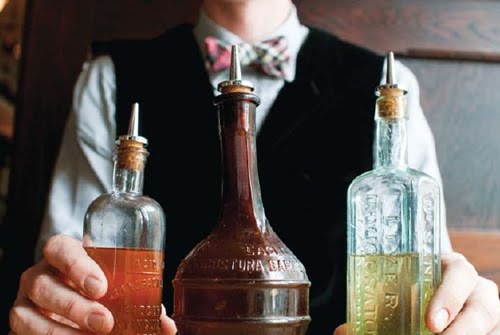Our friends from Seattle, let’s call them Joel and Greg, went to an Italian specialty and gourmet food and wine shop called DeLaurenti and were floored by the over sixty kinds of bitters that lined the shelves.
It prompted them to write something along the lines of: “What does everyone know about bitters that we don’t?”
Well, guys. Here’s our take:
First, DeLaurenti is our kind of field trip. You will learn more about bitters just reading the bottles and talking to the staff than you can possibly retain in one trip. So make several. And pick up a lemon & pimento chocolate bar for us.
You will learn that bitters are, be definition, “alcoholic beverages flavored with herbal essences and have a bitter or bittersweet flavor. There are numerous brands of bitters that were formerly marketed as patent medicines but are now considered to be digestifs rather than medicines. They commonly have an alcoholic strength of 45% ABV and, in addition to being used as digestifs, they serve as flavoring in cocktails.”
Now, since you can Wikipedia this stuff just as easily as we can, we’ll turn to some lesser-known facts about bitters:
• Bitters are vulnerable to extinction due to lack of use, warns freshfoodwriting.com. Please do your part.
• Bitters are not always bitter
• So-called strong bitters are used in small amounts — by the drop or half-teaspoonful — as flavoring. Popular brands of strong bitters include Angostura (from Trinidad), Peychaud’s (New Orleans) orange bitters and peach bitters (England).
• Bitter aperitif wines are usually served on the rocks. Some you may know by name as: Amer-Picon (France), Cynar, Campari and Fernet Branca (Italy) and Gammel Dansk (Denmark).
• Cynar (pronounced “chee-nahr”) takes its flavor from artichoke leaves and is taken before dinner in Italy, on the rocks, often with a slice of orange.
• World-famous Campari is taken on the rocks, mixed with soda, and is the foundation for the classic negroni cocktail.
• Fernet Branca is arguably Europe’s most popular digestif
If you’d like to hop on the bitters bandwagon, stock your bar with Angostura, Peychaud’s and orange bitters to start. And a bottle of gin and you’ll have a good old time doing some extracurricular after-work projects. They may be stupendous or disastrous. You and your guests will be amused either way. For bitters by the book, get your hands on Stuart’s Fancy Drinks and How to Mix Them. This is thirteen bucks well spent (and yet another amusement for you and your friends).
There are also classes on the use of bitters. This might be a fun, Yuppy thing to do, particularly if you have a lot of parties or are thinking of bartending on the weekend for extra cash. But don’t miss your kid’s Little League game for it. Everything you need to know about bitters can be learned through self-guided research.


